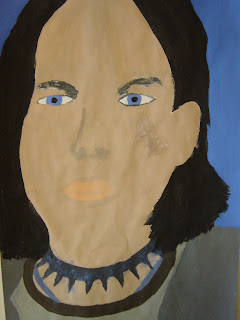

Lesson Plan for
Elementary Art
Teacher: Mr. Cooper-Davis Grade: 6th-8th Quarter: Week:
| Fine Art Standard(s) 25.A.1d 26.A.1e | | Performance Descriptor(s) Identify the elements of line, shape, space, color and texture; the principles of repetition and pattern; and the expressive qualities of mood, emotion and pictorial representation. Identify media and tools and how to use them in a safe and responsible manner when painting, drawing and constructing. |
Objectives:
| · TLW demonstrate knowledge of correct facial proportions · TLW create two complete practice drawings of the face in portrait and profile (using correct proportions) · TLW demonstrate measuring in various inch increments · TLW create an exact copy of a drawing using the grid system · TLW create a self portrait contour line drawing using a 1:2 grid ratio | · TLW practice various basic art room procedures · TLW demonstrate each art room procedure · TLW recall the 3 art room rules |
| | Formative Assessment | Summative Assessment | |
| | · Check students for participation + daily working attitude (points earned)- visual | · Teaching Scoring Guide used in “Self Portrait Grid Paintings” | |
Student Learning Opportunities:
| Strategies | Student Learning Activities |
| · Games/ group activities · Visual · Individual Experimentation/ Activities/ Projects | · Review Procedures : “Hand does the Talking” /“Freeze/Thaw”/“Ready to Work” / “Clean Up” Review Painting Procedures · First ½ of class- finish Geometric Paintings · Review Portraits (what is it) types?/ Portrait (front), Profile (side), ¾ view · Proportions: what are they? Face is more or less symmetrical from left to right (what is symmetrical)/ it is also measurable · Portrait activity: As a class, students will create their own portrait and profile views of the face. I will demonstrate step by step where facial features should be located- students will have a chance to add details to the faces after we have finished with the basic elements · If time- introduce using a grid to create an accurate copy of a drawing · Review using grids- all students need to be comfortable using them/ understand concept before moving on to drawing portrait. · Introduce measuring in 1 inch increments- creating a 1 inch grid over their self portrait (draw lightly- erasing will destroy the portrait) · Introduce measuring in 2” increments- creating a 2” grid on their project paper: Extremely important to draw lightly- makes the lines easier to erase when finished. · Introduce creating enlargements using grids- Students may begin drawing their portraits once their grids are correct. · Begin/ continue working on drawing their portraits- work slowly- draw only lines in 1 square at a time · Students finished with their drawing may begin painting · Classes painting review painting procedures/ monitor duties/ requirements during painting |
Resources (Materials/Texts/Visuals/Technology):
| pencils, portrait worksheets, erasers, overhead sheets, overhead pens, overhead projector, 12X18” paper, Painting Cart |
Misc:
| “Self Portrait Grid Paintings”: Students will be creating their second self portrait. This self portrait will be an enlargement of an original picture. Students will need to create a 1X1” grid on their pictures of themselves and a 2X2” grid on their paper. After creating the contour drawing of themselves, they will erase the grid and begin to paint their portrait. |





